Diptera.info :: Identification queries :: Diptera (adults)
|
Hydrophoria lancifer (Anthomyiidae)
|
|
| Susan R Walter |
Posted on 23-11-2008 18:53
|
|
Member Location: Touraine du Sud, central France Posts: 1802 Joined: 14.01.06 |
Any thoughts on what this one might be? It has a mean looking set of katepisternal bristles (which may or may not be relevant) and long hairs on the arista (slightly shorter underneath), but I didn't succeed in keying it. Female, 8.5mm, lowland central France (la Brenne) <100masl, damp woodland, from 2 June 2008. (Title edited from Muscidae to Hydrophoria lancifer (Anthomyiidae)) Susan R Walter attached the following image: 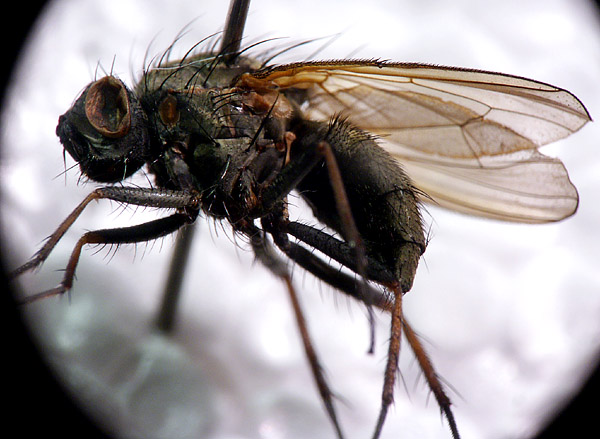 [94.24Kb] Edited by Susan R Walter on 23-11-2008 23:38 Susan |
| Nikita Vikhrev |
Posted on 23-11-2008 22:11
|
|
Member Location: Moscow, Russia Posts: 9500 Joined: 24.05.05 |
Something well known  I'd like to see one more image. Nikita Vikhrev - Zool Museum of Moscow University |
|
|
|
| Stephane Lebrun |
Posted on 23-11-2008 22:33
|
|
Member Location: Le Havre, France Posts: 8248 Joined: 03.03.07 |
Are we sure it's well Muscidae with these small calypters and ks setae arrangement. Could be an Antho, Hydrophoria. Are ther 2 strong pd on hind tibiae ? Like Nikita, I say "more pictures please". 
Stephane. |
|
|
|
| Susan R Walter |
Posted on 23-11-2008 23:46
|
|
Member Location: Touraine du Sud, central France Posts: 1802 Joined: 14.01.06 |
Ahem...(embarrassed cough) ...I think it is Hydrophoria lancifer. It has interfrontals, little hairs under the scutellum, 3 dc – in short, it is clearly an anthomyiid. ...I think it is Hydrophoria lancifer. It has interfrontals, little hairs under the scutellum, 3 dc – in short, it is clearly an anthomyiid. In my defence, can I just say that yesterday when I looked at this fly and wrote my notes, I had a migraine, and three flies later gave up and took to my bed. 
Susan R Walter attached the following image: 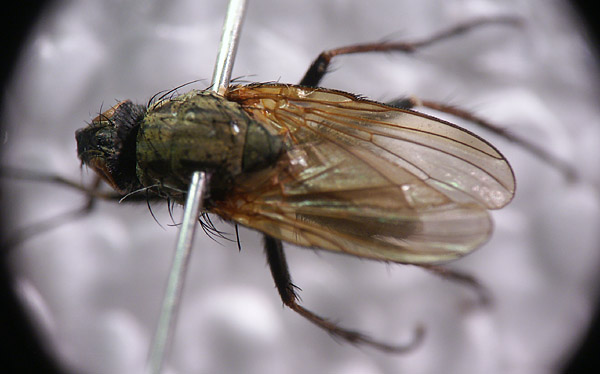 [63.41Kb] Susan |
| Susan R Walter |
Posted on 23-11-2008 23:47
|
|
Member Location: Touraine du Sud, central France Posts: 1802 Joined: 14.01.06 |
Head
Susan R Walter attached the following image: 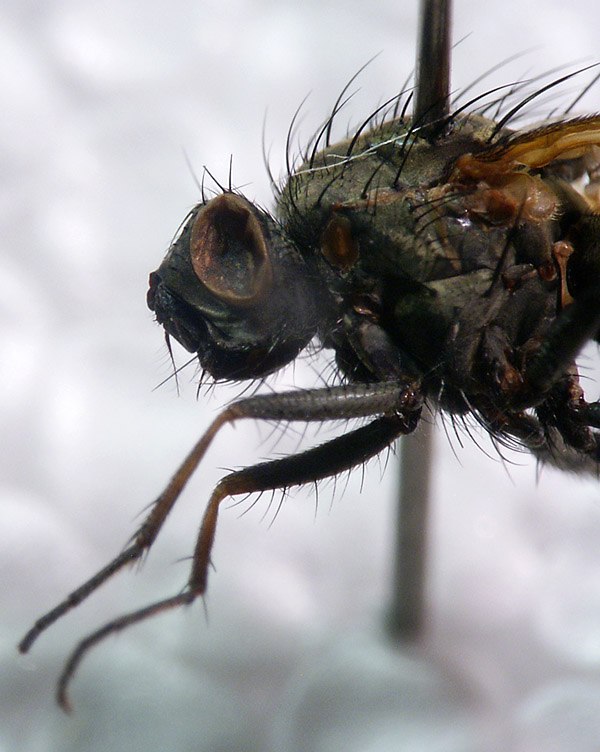 [120.71Kb] Susan |
| Susan R Walter |
Posted on 23-11-2008 23:48
|
|
Member Location: Touraine du Sud, central France Posts: 1802 Joined: 14.01.06 |
Hind tibia.
Susan R Walter attached the following image: 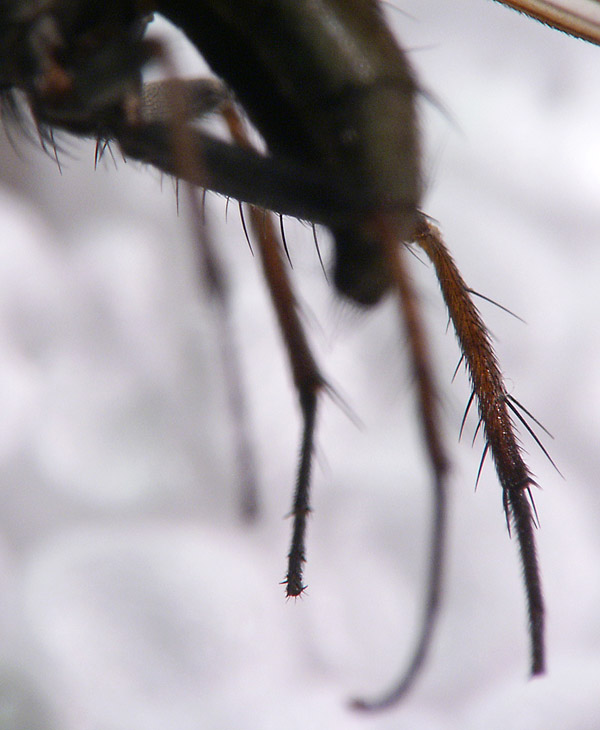 [90.74Kb] Susan |
| Susan R Walter |
Posted on 23-11-2008 23:48
|
|
Member Location: Touraine du Sud, central France Posts: 1802 Joined: 14.01.06 |
Another pic of whole fly.
Susan R Walter attached the following image: 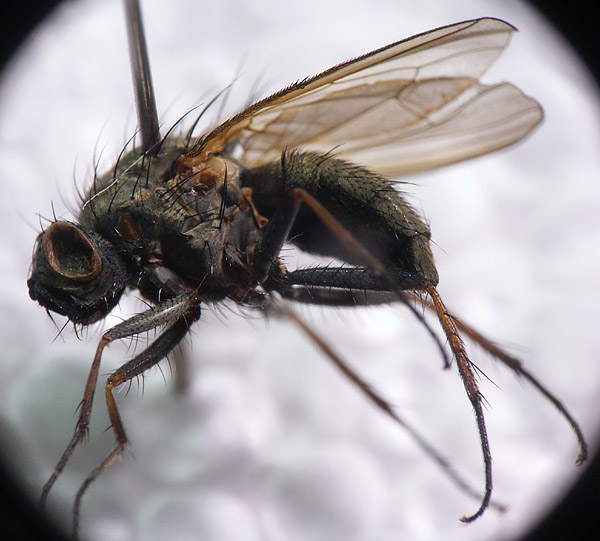 [93.34Kb] Susan |
| Michael Ackland |
Posted on 24-11-2008 11:11
|
|
Member Location: Dorset UK Posts: 680 Joined: 23.02.08 |
Plumose arista, 3-4 av on hind tibia, 4 katepisternal setae, rather long distal dorsal setae on hind tibia--all point to Hydrophoria lancifer. I can't see clearly the discal surface of the scutellum, which should be covered with small setulae (distinguishing Hydrophoria from Hylemya), can you check this Susan? Two further characters which point to lancifer: long pra seta, and 2 upper anterior anepisternal setae. The only character that puzzles me is the rather wide genae, perhaps due to angle of vision, or head somewhat distorted? |
|
|
|
| Susan R Walter |
Posted on 24-11-2008 22:49
|
|
Member Location: Touraine du Sud, central France Posts: 1802 Joined: 14.01.06 |
Michael – yes there are setulae all over the top of the scutellum, concentrated particularly along the central area. The acr are clearly closer to each other than to the dc on this fly and on several of my other specimens from this day, so I am happy that they are H lancifer. I can't explain the genal width in this fly. This specimen was significantly bigger than all my other H lancifer from this day though – 2mm bigger than the next biggest one. What are my chances of also having a few H ruralis mixed in with them? In one or two of the specimens the acr and dc seem more evenly spaced, so I wondered if they might be ruralis instead. Susan |
| Michael Ackland |
Posted on 25-11-2008 16:30
|
|
Member Location: Dorset UK Posts: 680 Joined: 23.02.08 |
H. ruralis has some yellow/orange on the abdominal base and partly yellow legs; annulata has all black legs. Both species are common and often swept up with lancifer. |
|
|
|
| Jump to Forum: |













